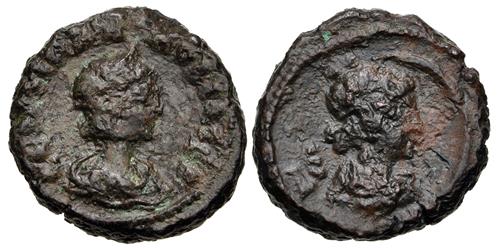
|
EGYPT, Alexandria. Zenobia. Usurper, AD 268-272. Potin Tetradrachm (20.5mm, 8.91 g, 12h). Dated RY 5 of Vabalathus (AD 272).
Electronic Auction 457
Lot: 218. Estimated: $ 1 000
Roman Provincial, Potin
Sold For $ 1 500. This amount does not include the buyer’s fee.
Go to Live
|
|
EGYPT, Alexandria. Zenobia. Usurper, AD 268-272. Potin Tetradrachm (20.5mm, 8.91 g, 12h). Dated RY 5 of Vabalathus (AD 272). Draped bust of Zenobia right, wearing stephane / Draped bust of Selene right, her hair tied in a knot at the top of her head; crescent moon to right; L Є (date) to left. Köln –; Dattari (Savio) 5513; K&G 108.5; Emmett 3913.5 (R3). Glossy dark brown patina with touches of green, rough surfaces. Fine. Very rare.
Ex Classical Numismatic Group Electronic Auction 258 (22 June 2011), lot 279.
The widow of Odenathus, the ruler of the rich eastern trade center Palmyra, and the mother and regent of Vabalathus, Septimia Zenobia became a powerful regional ruler in her own right. Granted de facto power in the East by the emperor Gallienus to counteract the Persian advance, Odenathus used the opportunity to establish his own separatist kingdom. When Odenathus was murderered in AD 267, Zenobia used the moment to advance her son Vabalathus. Since he was still in his minority, Zenobia took over as regent, using the position and the confusion following the death of Gallienus to establish her position between Rome and Persia and expand Palmyrene power. In AD 269, the Palmyrenes seized control of Egypt and, with it, the Roman grain supply. To bolster her position, Zenobia laid claims to an illustrious ancestry, including Cleopatra VII of Egypt and the legendary Dido of Carthage.
The emperor Aurelian recognized the threat posed by Zenobia and launched a campaign against her. In AD 272, Palmyra was sacked and both Zenobia and Vaballathus were captured as they tried to make their way to Persia. She was brought to Rome and paraded in Aurelian’s triumph in AD 274, bound in gold chains. According to later tradition, Aurelian, impressed by her beauty and dignity, later freed her, and granted her a villa in Tibur, where she spent the rest of her life.
Closing Date and Time: 4 December 2019 at 11:12:20 ET.
All winning bids are subject to an 18% buyer’s fee.
|
